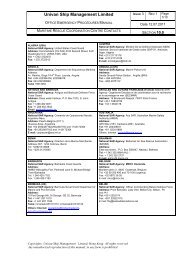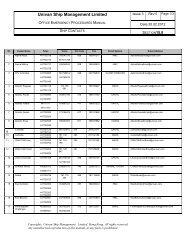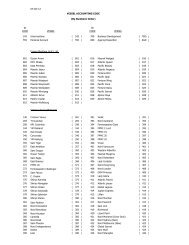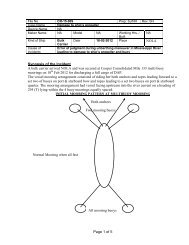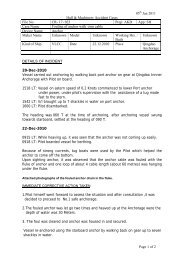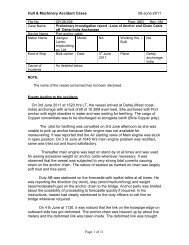Section: 11 CARGO OPERATIONS - Univan
Section: 11 CARGO OPERATIONS - Univan
Section: 11 CARGO OPERATIONS - Univan
Create successful ePaper yourself
Turn your PDF publications into a flip-book with our unique Google optimized e-Paper software.
<strong>Univan</strong> Ship Management Limited Issue 1 REV 0 Page<br />
1/7<br />
FLEET OPERATION MANUAL Date 01.01.2005<br />
<strong>CARGO</strong> SECURING PROCEDURES<br />
<strong>11</strong>.4 Procedures for cargo stowage and securing<br />
<strong>11</strong>.4.1 Cargo securing manual<br />
Copyrights: <strong>Univan</strong> Ship Management Limited, Hong Kong. All rights reserved<br />
Any unauthorized reproduction of this manual, in any form is prohibited<br />
SECTION <strong>11</strong>.4<br />
On a Pure Car Carrier Vessel, the cargo should be stowed and secured as per the cargo securing<br />
manual. This manual is class approved and issued under the guidelines of IMO MSC/Circ. 745.<br />
Cargo Securing Manual should be particularly referred when loading non standard cargoes. The<br />
basic contents of cargo securing manual is as follows:<br />
<strong>11</strong>.4.2 Types of lashing gear<br />
On these specialized vessels, there are special lashing materials, particularly designed for<br />
individual cargoes. The most common ones are explained here. The lashing material used should<br />
be as per Cargo securing Manual. The record of inventory of all the approved lashing material<br />
along with their test certificates should be maintained in the cargo securing manual.<br />
Given below is the chart of lashing material commonly used on PCC vessels. These lashing<br />
materials are for standard cargoes. And for non standard cargo we have to refer to vessels Cargo<br />
Securing manual.<br />
<strong>11</strong>.4.3 Procedures for lashing cars.<br />
The lashing of the cars should be done as per vessels cargo securing manual. However salient<br />
features of securing these cars are explained in this section. The basic purpose of lashing is to<br />
secure the cargo. Secure the cargo in such a way that in worst of sea conditions, the cargo will<br />
still remain secured at its original place. Practically this objective may be hard to achieve, but we<br />
should endeavor to achieve this objective.<br />
Also note that cars are very delicate cargo. Even a minor scratch on the car body will cause the<br />
cargo to be rejected. So while lashing we have to take utmost care that no damage to any part of<br />
the loaded cars take place.<br />
Following are the procedures and precautions required to be followed while lashing the cars:<br />
The lashings and other securing material should never be carried in between stowed<br />
vehicles. If unavoidable utmost care should be exercised.<br />
The lashing material should not be thrown.<br />
Never lean, step on to or sit on a vehicle.<br />
Never keep any material, even helmets on the stowed cars.<br />
The lashing work should commence about 30 sec or 1 minute after the car engine is<br />
stopped.<br />
After the driver is out please ensure all the convex mirrors are correctly stowed in. There<br />
is no light on in the car cabin. The ignition key is not on. The gasoline tank filling caps are<br />
in place.<br />
Check the cigarette lighter is not pressed in, this may be a high risk fire hazard.<br />
In the vehicle is stowed in a slope way, the must be placed in such a way that vehicle<br />
front is pointing down slope. This is to prevent any drainage of fuel from the engine. Or<br />
otherwise you may face problems while starting wrongly stowed cars in discharge port.<br />
By thumb rule two lashings in front and two lashings in the rear are enough when the<br />
cars are secured in fore and aft direction.<br />
When the vehicles are stowed in the slope way, we are required to take four lashing are<br />
required to be taken at the rear and two in front.<br />
It should be kept in mind the best lashing is the one making an angle of 45 degrees to the<br />
deck plating.



